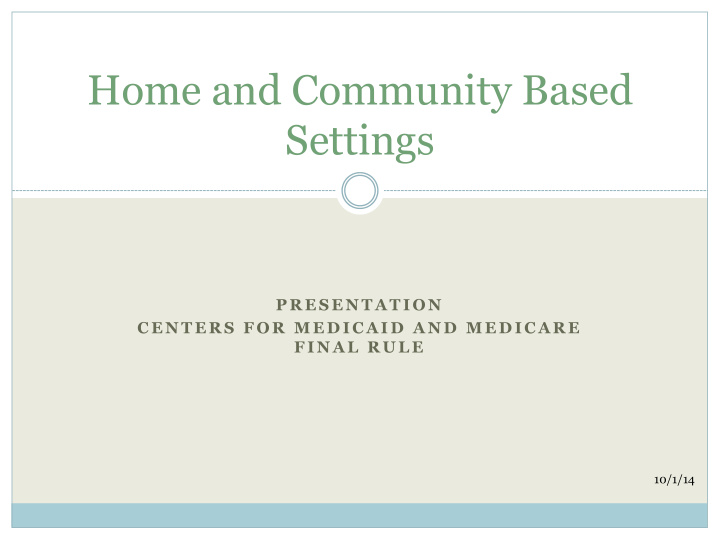



Home and Community Based Settings P R E S E N T A T I O N C E N T E R S F O R M E D I C A I D A N D M E D I C A R E F I N A L R U L E 10/1/14
Presentation will cover: 2 HCBS Final Rule 42 CFR Parts 430, 431, 435, 436, 441 and 447 How Washington measures up Modifications to requirements in provider owned settings including evidence for settings presumed to be institutional Washington’s Transition Plan
Intent of Final Rule 3 To ensure that individuals receiving long-term services and support have full access to benefits of community living and the opportunity to receive services in the most integrated setting appropriate
Integration in the community 4 The setting is integrated in and supports full access of individuals to the greater community, including opportunities to: Seek employment and work in competitive integrated settings, Engage in community life, Control personal resources, and Receive services in the community, to the same degree of access as individuals not receiving Medicaid HCBS
Choice 5 Setting and provider is selected by the individual from all available alternatives, including non- disability specific settings and an option for a private room. Facilitates individual choice regarding services and supports, and who provides them.
Choice 6 Freedom to: Furnish or decorate sleeping or living unit Control schedule and activities and have access to food at any time Have visitors of their choosing at any time RCW 70.129.140 (2), RCW 70.129.100, RCW 70.129.050
Rights 7 The setting ensures an individual’s rights of privacy, dignity and respect, and freedom from coercion and restraint. Dignity, respect and free of restraints RCW 70.129.005, RCW 70.129.120
Independence 8 The setting optimizes and does not regiment the individual’s: Initiative Autonomy Independence in making life choices, including: daily activities, physical environment and with whom to interact Setting is physically accessible to the resident Promoting Independence: RCW 70.129.140
Rights 9 The unit or dwelling is a specific physical place that can be owned, rented, or occupied under a legally enforceable agreement by the individual receiving services, and the individual has, at a minimum, the same responsibilities and protections from eviction that tenants have under the landlord/tenant law of the State, county, city, or other designated entity.
Privacy 10 Each individual has privacy in their sleeping or living unit: Units have entrance doors that can be locked by the individual with only appropriate staff having keys to doors Individuals have a choice of roommates in the setting
Modifications to the Rules 11 Criteria to modify setting requirements : Be based on an assessed need and justified in the service plan Be used only after positive supports have been used and documented Less intrusive methods have been tried and documented Include data collection measures and documents ongoing effectiveness of the modification
Modifications to the Rules 12 Criteria to modify setting requirements : cont. Include established timeframes for reviewing continued need for modification Include informed consent of the resident Include assurance that the modification will do no harm to the resident
Special Note About Delayed Egress 13 Must be individually based Documented in the Care Plan Need must be reviewed periodically Must have appropriate signage by the door People who don’t require delayed egress should not be restricted from exiting the building Secured courtyard/outdoor area
Settings Presumed to be Institutional 14 CMS presumes settings to have the qualities of an institution when they are: Located in building that provides inpatient institutional treatment or Located on the grounds of or adjacent to a public institution or Settings that isolate the resident from the broader community of individuals not receiving Medicaid HCBS
Settings Presumed to be Institutional 15 Evidence in the Transition Plan must: Show how these facilities protect the fundamental rights of freedom, dignity, control of daily routines, privacy, and community integration Include stakeholder input, especially from residents
Settings Presumed to be Institutional 16 HCS staff have conducted site visits and interviews with identified residential and adult day service settings. Information was gathered about: Choice in setting Community involvement Choice in roommates Choice in schedules Choice in food and who one eats with Freedom to have visitors at any time
Survey & Investigation 17 Residential Care Services is currently reviewing all facility survey tools to identify compliance changes Stakeholders from all facility types will be kept abreast of changes via: Professional websites Dear provider updates Presentations/meetings with associations
Transition Plan 18 Assessment Process: Includes the state’s assessment of the extent to which its regulations, standards, policies, licensing requirements, and other provider requirements ensure settings comport with the regulation. Systemic Review Site Specific Assessments Provider Assessments Settings Presumed Not to be HCB Summary From CMS presentation dated 9/11/14
Transition Plan 19 Remedial Strategy: Describes actions the state proposes to assure initial and on-going compliance with the HCBS settings requirements, with specific timeframes for identified actions and deliverables. Proposing new state regulations or revising existing ones Revising provider requirements Conducting statewide provider training on the new state standards. From CMS presentation dated 9/11/14
Transition Plan Time Frame 20 Submitted Statewide Transition Plans must include a time frame and milestones for state actions, including assessment and remedial actions. If state standards must be modified in order to effect changes in the state system, the state should propose a reasonable time frame for making the modifications. From CMS presentation dated 9/11/14
Washington’s Transition Plan TimeLine 21 Through end of October- gather stakeholder and Tribal input for draft transition plan October 23 -Tribal Consultation November - complete draft transition plan December- post plan for 30 day public comment December/January- gather public feedback and make any revisions to transition plan January- Submit transition plan to CMS and repost for public view
Comments and Suggestions 22 Please send comments and suggestions to: Barb Hanneman, HCS at hannebj@dshs.wa.gov or Bob Beckman, DDA at bob.beckman@dshs.wa.gov or Patty Craig, RCS at craigpl@dshs.wa.gov http://adsaweb:85/stakeholders/hcbs/
Recommend
More recommend